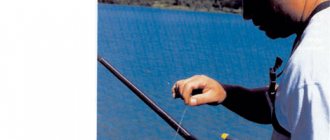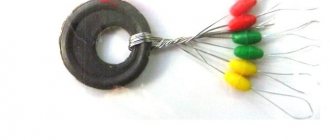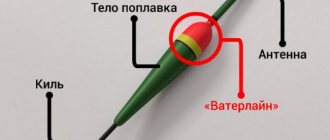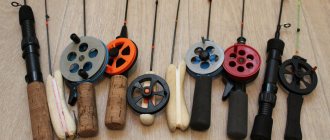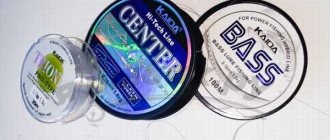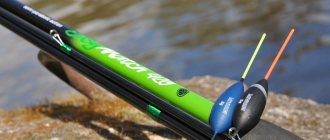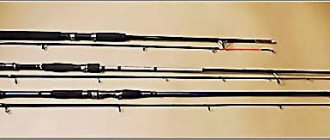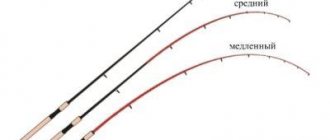If you are interested in float fishing or are planning to master this oldest form of fishing, then this article is for you.
Here we will introduce you to the most important and unique element in its properties - the fishing float. A fishing float is not only a bite alarm, but also an element of float equipment that has a multifunctional meaning, but you will find out what it is after reading...
Content
- 1. What is a float and why is it needed?
- 2. How the float works
- 2.1 Float antenna
- 2.1.1 Antenna color
- 2.1.2 Antenna size
- 2.1.3 Antenna material
- 2.1.4 Types of antennas and their applications
- 2.2 Float waterline
- 2.3 Housing (body) of the float
- 2.4 Float keel
- 2.5 Fastening elements
- 3.1 Float sensitivity
- 3.2 Float stability
- 3.3 Float capacity
- 4. What are the different forms of floats?
- 4.1 Olive shape
- 4.2 Ball shape
- 4.3 Drop shape
- 4.4 Float in the form of an inverted drop
- 4.5 Spindle float
- 4.6 Straight float
- 4.7 Flat float
- 4.8 Antennaless float
- 5. Useful video
- 6. Useful links
How to choose a float for a fishing rod
The choice of float for fishing largely depends on the fishing rod used. Now we will look at which floats to choose for a particular fishing method.
For fly fishing
Based on the characteristics of the fly rod, it can be noted that fishing will be carried out at close range. In this regard, we can conclude that we need a float with a thin antenna, it will be clearly visible, and as a bonus, we will increase the sensitivity of the float.
Next, you need to determine where you are going to fish, on a current or in a still body of water, as well as the fishing depth. Let's consider several options:
- There is a current of great depth: With a long keel and a rounded body
- There is a shallow current: With a short keel and a rounded body
- No current deep depth: Elongated float
- No current, shallow depth: Small elongated models, or a small float with a diamond-shaped body and a short keel.
For Bolognese fishing
Since the Bolognese fishing rod is universal, the above floats can be used on it for exactly the same conditions with a slight amendment. If you fish at a considerable distance (let go far), you will need a thick antenna.
If fishing will be carried out using long-distance casting, you need to choose a body shape that will combine aerodynamic properties and resistance to flow. The golden mean is a float with an “inverted drop” body.
For match fishing
In match fishing, special floats are used - wagglers. The choice of match float largely depends on the fishing range and the depth of the reservoir. If the reservoir is deep-water, floats with their own weight are used.
When fishing in shallows, using your own weight is unacceptable, since when casting, the float will dive almost to the bottom and scare away the fish. In this case, you need to use models with a shortened antenna without its own load.
It is almost impossible to choose a universal float in match fishing, so you should have several models with you and select them depending on the conditions. There is no need to worry about wind and current, as the wagglers deepen the line.
What is a float and what is it for?
A fishing float is one of the elements of float equipment that is attached to a fishing line (for example, monofilament).
Purpose of floats:
- Float - a bite alarm for a fisherman;
- By attaching a float to a fishing rod, the angler thus controls the depth of the bait, studies the bottom topography and monitors the location of the bait;
- Possibility of casting at a certain distance (long, medium or short).
- If you react correctly to this or that indication of the float and change it in time, then the hook will be timely, and the fish will reliably “sit” on the hook.
- They say that fishermen who have reached the highest levels of enlightenment are able to determine the type of prey based on the nature of the bite and correctly build a fishing strategy.
Float mounting options
Depending on the characteristics of the reservoir, the float can be attached in two different ways:
- The blind version is used at shallow depths not exceeding the length of the rod. Here you will need cambrics that are put on the keel. They press the line against the keel to make it difficult to slip.
- The sliding option is used for fishing depths exceeding the length of the fishing rod. In this case, there are two stoppers on the line, between which the float can move freely. The upper stopper determines the fishing depth.
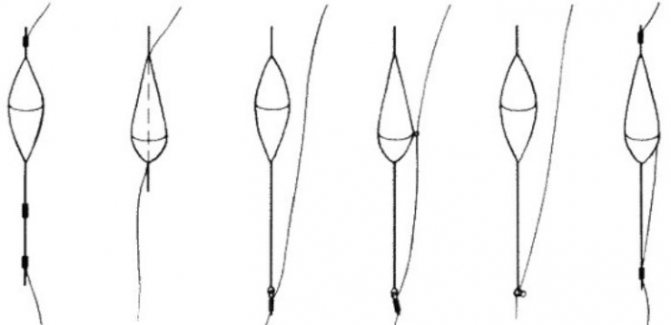
How does a float work?
All floats, regardless of their external design differences, have a similar structure. It is important to know the design of this accessory, to navigate the functionality of each of its parts, since this knowledge will be useful for building a hunting line depending on certain fishing conditions.
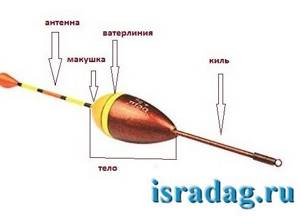
Main parts of the float:
- surface;
- underwater;
- waterline.
The purpose of the first part is to ensure that it is visible to the angler, while the waterline and underwater half are out of his field of vision. It is this half of the float body that has a different volume, which affects the carrying capacity of the float, and the part at the waterline affects its sensitivity.
2.1 Float antenna
The antenna is a continuation of the frame (body) of the float, has a design in the form of an elongated stick with a spherical tip or a drop-shaped tip and is made of different materials. The float antenna is the link between the fisherman and the float.
The main purpose is visibility of the location of the float, a message about its behavior to the fisherman during the fishing process, a bite alarm.
2.1.1 Antenna color
The color of the antenna of a fishing float is selected according to the following principle - the color should be sharply different from the color of the water in the reservoir.
The most popular colors are yellow and red. There is also a black color for the antenna, which many fishermen independently repaint their “connector”.
The angler's perception of color depends on many factors:
- light direction angle;
- degree of illumination;
- the presence of a shadow;
- fishing time, etc.
Based on this, using only red floats with an antenna in fishing may not always be favorable. The color scheme should be based mainly on the above factors.
Recommendations for using antenna color depending on fishing conditions:
- yellow and light green colors are effective in the early morning, in cloudy weather, in places with reflection, tall vegetation from the branches of which creates a shadow.
- red color - clearly visible on a sunny (clear) day, as well as when the sun is behind or to the side of the angler.
- The black color of the antenna is appropriate when the sun is located opposite the angler;
- Glowing antennas are used in night fishing.
Tip: pay attention to sets of floats; their use is convenient, since the set includes interchangeable antennas of different colors, which is very convenient for changing fishing conditions.
2.1.2 Antenna size
The size of the antenna depends on the casting distance of the equipment. So, the shorter the casting distance, the thinner the antenna should be and, with increasing range, increase in diameter. For example, every 5 m of casting requires an increase in the antenna diameter by 0.5 mm.
2.1.3 Antenna material
Stainless steel (steel) wire sinks in water, that is, it has a negative degree of buoyancy due to the excess density of water. It has a small thickness (0.5 - 1.2 mm), a length of up to 70 mm, high sensitivity and requires precision in loading. Area of application: fishing with small baits in good weather. Types of gear - plug-in float rod, when fishing at short distances, and can also be used with a fly rod.
Carbon fiber - has the same buoyancy as stainless steel, is also small in thickness, does not have light transmission, which implies use at short distances, with small baits and good lighting. As a rule, they have a length of up to 70 mm. In order to repaint a carbon fiber antenna, it must first be painted white.
Composite (fiberglass) - has different buoyancy, which depends solely on the manufacturer and composition. This material makes it possible to produce antennas of different diameters. Although they are multi-colored, they are clearly visible under different fishing conditions. Easily repainted, does not deform. Disadvantages - a thin, high-density composite works well in calm water without current, while a thick composite is difficult to balance due to its weight. Floats made of composite antennas of medium diameter are installed on a Bolognese, fly or match fishing rod, and thin ones are installed on plug tackle.
Polyethylene - has zero buoyancy, the density of such a material is almost equal to the density of water, is sensitive, transmits light, flexible, which allows you to avoid overlaps when casting, and is varied in diameters.
Polypropylene is a material with medium buoyancy, allows fishing in the current and in the bottom method (dragging along the bottom), has average sensitivity, is usually manufactured in medium and large diameters, has poor transparency and insufficient visibility.
Bamboo is highly buoyant, since the density of bamboo is higher than the density of water. Shows itself perfectly when fishing in windy weather and in currents. It has good visibility, but has a low degree of sensitivity, which allows you to miss a bite. It requires care and protection from water by impregnation, since, by absorbing moisture, it reduces its load-carrying capacity.
2.1.4 Types of antennas and their applications
What antennas and how to use:
- A thin antenna is used for fishing with small baits;
- Thick float antenna - for fishing with large baits;
- Long antenna – suitable for plug and match fishing;
- Short - effective for catching fish that live in the water column;
- Flat antenna design – suitable for fishing with plug tackle in the current;
- With a flared tip - great for long-distance throwing;
- With an extension in the central part - for bottom fishing with an anchored bait.
2.2 Float waterline
Waterline is the place separating the surface and underwater parts of the float, indicated by a line.
The position of this line depends on the following characteristics:
- Float shapes;
- Load capacity;
- Weight of the weight.
That is, if you change the weight of the load, then accordingly the waterline will change its position, on which the sensitivity of the fishing float depends, that is, the visibility of the bite when the float is in the water.
2.3 Housing (body) of the float
The body (body) is the central part of the float, which is responsible for buoyancy, therefore only lightweight materials are used in its manufacturing process. The keel gives the float stability on the water.
2.4 Float keel
It is interesting that many amateur fishermen do not pay special attention to this detail, but in vain. The float keel is one of the parts of the float that performs a number of special tasks:
- tying the float and fishing line;
- stabilization of the float on the water;
- maintains its balance under all fishing conditions, including the impact of equipment elements;
- quickly puts the float in a vertical (working) state, that is, a bite state.
Float keel characteristics:
- material;
- length;
- diameter;
- buoyancy.
As for the material used to make this part, it is identical to the material of the antennas.
The diameter and material directly depend on the fishing conditions. The main task of any keel is the ability of the float to quickly return to its original, ready-to-signal state. Keels with the lowest degree of buoyancy and made of wire, aluminum, carbon fiber, and fiberglass are excellent for this. Such “heavy” keels help to instantly stabilize the float in windy weather and when manipulating the equipment.
When using a metal keel, you need to consider the following important points. Firstly, the weight of this element requires the use of less loading weight.
Secondly, the center of mass changes, which gives an additional opportunity for the float and weight to rotate, which can provoke unwanted overlap of the equipment. All these circumstances reduce the possibility of casting over medium and long distances.
Thirdly, if you are fishing at significant depths and fishing, then due to the reduced weight of the load, the bait takes longer to sink to the intended depth and all this time the equipment is in motion, swimming a considerable distance, which is absolutely not necessary for you. To avoid this phenomenon, floats with a larger load capacity are used, but this makes the equipment crude.
Conclusion: a metal keel is suitable for specific, extreme fishing conditions.
If you choose a float with a long keel, remember that the advisability of using an extended keel depends on the depth. For example, if you are fishing in shallows or in the upper layer of water, then an elongated keel will hinder you, since it will quickly take the desired position, while the bait has not yet had time to descend to the desired point. Under such circumstances, you will miss the bite. The opposite picture awaits you when fishing in windy weather and waves. Here a more serious load is required, which will ensure the balance of the float thanks to the heavy keel and the rapid immersion of the bait.
The maximum dimensions of a metal keel do not exceed 12 cm; a larger size will not allow it to be balanced, but keels made of fiberglass and carbon fiber are from 10 to 20 cm (standard length).
The thickness of the keel should be equal to the thickness of the antenna.
Recommendations if you choose a float based on the keel diameter:
- The small carrying capacity and compactness of the float body (for example, a drop float, a needle or a float in the form of a spindle) requires the use of a thinner keel with an average length, made of carbon and fiberglass 6-14 cm, and less from metal.
- The shape is in the form of an inverted drop or spherical - the keel is larger in diameter and no more than 16 cm long.
2.5 Float fastening elements
Options for attaching a fishing float to a fishing line

Passage rings are provided for attaching the float to the fishing line. The specific location of the rings on parts of the float is important when fishing on water with a current in order to hold the bait at one point.
Some float models have, instead of rings, a recess that runs along the float body. This type of fastening is intended for cases of catching trophy specimens with heavy loads.
Float fishing rod - subtleties of equipment
Float rod. This is probably where all young anglers started. Actually, this post is for them, beginners. Today I am more interested in spinning, different styles of spinning. But, 3-4 times a season I devote time to other types of tackle: feeder, bottom and float rod. So, combined with my past experience, I have a lot to talk about. ?
So, let's collect the gear. For each piece of equipment I will give some advice and comments from my own experience.
I’ll make a reservation right away. We will talk about gear for fishing in still water or in weak currents. The depth at the fishing spot is up to 3-4m. The lion's share of coastal areas of lakes, ponds, rivers, swamps, and in many cases not only their coastal areas, will fit these parameters.
In deeper places and with a noticeable current, slightly different options for float rods will be used (with a sliding float, wire rods, etc.), and usually, in such conditions, it is more advisable to switch to a feeder, spinning rod, etc.
There are different conditions. In some places it is enough to cast the fishing rod 1-2m from the shore, in others it is necessary to cast 10-15m or more. There are also different conditions in terms of depth, water color, size and types of fish caught. You can’t create an arsenal of several dozen float rods, tailored to each type of conditions. The most versatile tackle should be created. Why? Often we do not know the situation on a reservoir; it can be changeable. In addition, an angler often moves during one fishing trip between several fundamentally different areas and even bodies of water. So, I will tell you about the most versatile fishing tool with a float. Such a float fishing rod and equipment will allow you to cover a maximum of water conditions. This is my subjective opinion. In some ways, someone may disagree.
I'm ready to argue in the comments.
Rod for float rod. I prefer a telescopic rod. The fishing rod must have guides and a reel seat. It is the sliding equipment, and not the blind one, that turns an ordinary float fishing rod into a rather lethal, long-range and universal tool - a fishing rod for long-distance casting.
Regarding other characteristics of the rod. Length 4-4.5m. I think that less than 4m is a bit short. And only when fishing in cramped conditions: among bushes, under overhanging trees, sometimes a stick 3-3.5 m long can work. At the same time, longer rods 5-6m or more do not make sense. The longer the rod, the heavier it is. And excess weight is excess.
In addition, a couple of extra meters of rod length provide a minimal gain in casting distance. With a 4-meter fishing rod, we can perfectly place the equipment 15-20m from the shore, thanks to the reel.
Also based on the weight of the rod. It is clear that ideally you need to have the lightest and at the same time durable fishing rod. These are mutually exclusive characteristics. Those. in low-budget rods, which are used by 99% of domestic floaters, this is the case. If the rod is light, then the wall of the tubes is thin, you can literally press it with your finger. Naturally, such fishing rods break very quickly and at the most unfortunate moments. At the same time, there are fishing rods with thicker walls - they are strong, durable, but heavy. We need to find a reasonable balance. Choose a rod with sufficient strength and moderate weight. In the end, we don’t always hold the fishing rod in our hands, suspended. We often use various stands and flyers.
There is an option to buy an expensive fishing rod made of cutting-edge material: light as a feather and incredibly durable. There are such products. But, for example, I can throw away hundreds of bucks on spinning baits and gadgets, but I feel sorry for elite float rods.
I use two fairly cheap rods, each 4m long, of moderate weight. In terms of durability, both survived 5 and 15 years of use. I'm happy. If you are mainly interested in float, you should think about it and buy high-quality modern fishing rods. A reel for a fishing rod. A reel for a float rod, in my opinion, is simply necessary. I use small to medium spinning reels on my fishing rods. Such a reel makes it possible to: A) Make long casts; B) Quickly lengthen and shorten the fishing line; C) Fight large fish using a friction brake.
Depending on the task and the fish being caught, different sizes of reels are used. For light equipment, with which we will catch small roach, crucian carp, a fairly small reel, size 500, 1000, 1500, will be suitable. For more powerful equipment, if we catch bream, carp, etc. – 2000—3000.
The requirements for a spinning reel for a fishing rod, of course, are not as stringent as for a spinning rod. Here we are not dealing with braided cords - we use monofilament, which does not saw the rollers or strip the beads of the spools. There is also no such load. If on a spinning rod we rewind hundreds of kilometers of line per season, then on a fishing rod there is much less manipulation.
So, a very inexpensive reel will do. It is important that the brake is sensitive; The line roller was spinning and the motion was quite smooth. All. The number of bearings, spool material, and the presence of an instant reverse stop do not matter much. It’s also worth looking at the price tag and comparing it with the quality of workmanship and durability of the reel. So, I preferred reels for $15-20 (Okuma, Favorite) over reels for ($5-8), because... the former will last at least 3-5 seasons, while the latter are unlikely.
As for the friction brake, I prefer the front one because... it is usually more sensitive than the posterior one. But, this is a matter of taste.
Line for fishing with a float. Now there is a huge selection of high-quality fishing lines on the market. What is a good fishing line for a float rod? Durable - understandable. The diameter of the main line can be different. For delicate equipment: 0.18-0.2mm; for a more powerful one 0.22-0.3mm. Color – universal transparent. If fishing is in dark water: black, brown. On a clay bottom it is brown. On a sandy bottom - yellow. In an overgrown pond - green.
Line length. Usually one 100-meter reel is enough for 2 fishing rods, 50 meters each. You can wind 100... If you wish. You should wind backing or old fishing line onto the spool so that the main line is wound close enough to the collar. This will ensure a longer cast.
Other important characteristics of fishing line: memory and buoyancy. It’s good if the fishing line has minimal memory for bending, torsion, etc. It is also good if the line sinks slowly. It is extremely unpleasant when the fishing line lies on the surface of the water and the side wind blows a loop out of it. The float is dragged behind this arc of fishing line and all the raspberries are spoiled...
Float for fishing rod. The shapes and sizes of floats may vary. The main struggle is between long, thin floats and short, pot-bellied ones. In addition to the property of making noticeable circles, pot-bellied floats lose. I would use them only when fishing near the surface or in the mid-water of some upper water...
For fishing in calm water, from the bottom, long floats are better. Designs can be different - it's a matter of taste.
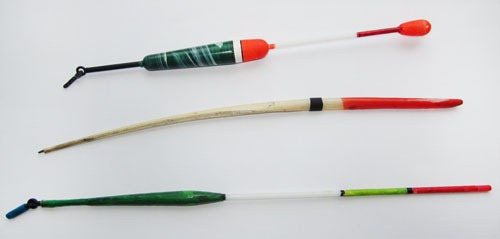
May have an oblong, cigar-shaped body made of hard foam and a long antenna. It can be a molded plastic float, or a classic goose feather.
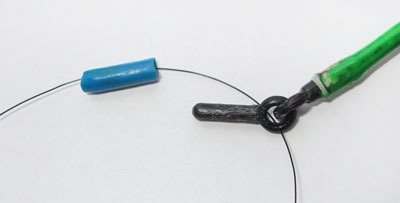
Floats are attached to the fishing line, usually using rings installed at the bottom of the antenna or directly behind the antenna. Fixation is done using tubes. These are just pieces of insulation from wires of a suitable diameter.
In order not to lose the float from inadvertently cutting the cambric with fishing line, you should play it safe and when installing the tackle, thread the fishing line through the ring.
Thus, the fixed float should, with some effort, move along the fishing line - depth adjustment. But don't drive on it freely.
Sinker for a float fishing rod. You can use a blind sinker or a sliding one. A dead weight is a piece of lead clamped onto a fishing line. I prefer sliding sinkers. I take a pellet and punch a hole in it with a needle. To do this, I clamp the needle in pliers so that the tip remains sticking out, comparable to the diameter of the pellet. I press the shot against a wooden board and gradually press the needle into the lead, punching the shot right through.

Such a sliding sinker gives less resistance when biting, does not alarm the fish as much, and makes the equipment more sensitive, because the impulse from the bite goes along the line to the float, without being loaded by the weight of the weight.
I try to choose a weight so as to load the float with one fractional or store-bought olive with a hole. The combination of pellets and a small fixed weight is not so good, because... the hole on the sliding weight is broken and rolled due to impacts against a stationary clamped piece of lead.
The load stopper is a loop knot to which the leash is attached. Or a stopper is used.
Adjusting the fishing rod float.

Leash. So, a double loop was tied at the end of the main fishing line. We will attach the leash to this loop using the “loop-to-loop” method.
A leash is a piece of fishing line thinner than the main one. This is necessary so that if the tackle breaks on a hook or on a large fish that is incompatible with the tackle, we lose only the leash and hook, and not the entire equipment (float, weight). This is a conscious weak point of the equipment. The leash is made 10-20cm long, depending on the timidity of the fish. You can make a leash from thin fishing line or fluorocarbon. The ratio of the diameters and strengths of the main line and the leader line is not an acquired taste. It is important that the leash breaks with less force than the main one. But the difference in diameter should be small, about 0.025-0.05mm. A hook is attached to the leash.
Accordingly, if we catch small roach, rudd, crucian carp, then the diameter of the leash can be taken as minimal as 0.08mm - 0.12mm. If we catch bream, good crucian carp, perch, then: 0.15mm - 0.17mm. And if there is an opportunity to catch a few kilograms of carp, or ide, then: 0.18mm - 0.25mm.

Float rod hook. The hook can be very different, depending on the type of bait and the size of the fish. To fish with maggots, this will be the thinnest, smallest hook. When fishing with a large earthworm, it is quite an impressive hook.
We will crochet the hook using a classic knot.
So, what kind of fish can be caught with gear arranged according to the above diagram? Very varied! A thin, elegant version will be good for catching roach, silver bream, white bream, and small crucian carp. A more powerful option (with a thicker line, a larger hook) for catching carp, carp, bream, ide, chub, perch. And this list can go on for a long time. So, a beginner who has built his float rods according to this principle can successfully fish in many bodies of water, in different places.
What are the different forms of floats?
The stability and sensitivity of the float depends on this parameter.
4.1 Olive shape
It is a universal form of float, as it is applicable both in water with and without current. A float with this shape is resistant to water and wind.
Where are olive-shaped floats used and with what weight:
- 0.5 – 1 g – standing water, water with a small river current and a depth of no more than 2 m;
- 1 – 3 g – at a depth of 3 m, and at an average flow speed at a depth of 1.5 – 4 m;
- 4 – 6 g – with medium and strong current at a depth of 4 to 7 m.
4.2 Ball shape
It is one of the universal fishing floats.
Where is a ball-shaped float used:
- on currents of varying intensity;
- in standing water;
- in windy or calm weather.
The downside is that it is less sensitive than an olive float.
4.3 Drop shape
The center of gravity in such floats is shifted downwards due to the thickening of the shape of the float body at the keel. Thanks to this, the float is stable in water with an average current speed. Excellent for all types of float rods and for fishing at depths of 1.5 m or more.
4.4 Float in the form of an inverted drop
If fishing takes place on a deep-water river with an area larger than the average size with any current, then floats in the form of an inverted drop will turn out to be, by the way, and if you use a float on Bologna gear for the purpose of free floating of the float, then this is the best choice for such conditions.
4.5 Spindle float
Cigar-shaped floats or spindles are not afraid of water ripples and strong winds. They perfectly show the most capricious bite.
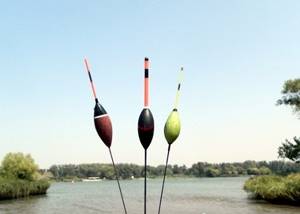
Advantage of floats:
- when fishing with a hold, which happens exclusively with Bolognese tackle, the float does not come out of the water and the angler records bites;
- work at a depth of 0.5 - 2 m.
For reference! Hold fishing is a method in which a float with Bologna equipment floats at a speed lower than the current speed, which allows the bait to move more slowly relative to other underwater inhabitants and the fish distinguishes the bait from the general picture and “bites” on it.
Disadvantage - in case of strong waves of water, current and wind, a float in the form of a spindle with an elongated body is not used due to its instability under such fishing conditions.
Despite this drawback, a spindle-shaped float can have different shapes of keel, antenna and body, which allows the fisherman to choose the right float for specific fishing conditions:
- a float with a long body and a medium keel is used for fishing in water without or with a weak current;
- a float with a short body design and an elongated keel is used in windy conditions, but in water with a slight current.
Also, the choice of float depends on the type of bite:
- a float with a short antenna works to catch a bite;
- A float with a streamlined shape and a medium antenna is universal.
4.6 Straight float
This form of floats can be used when fishing in small ponds (lakes), the depth of which is no more than 2 m. However, the disadvantage of this form is that a straight float will not withstand the test of bad weather (for example, wind).
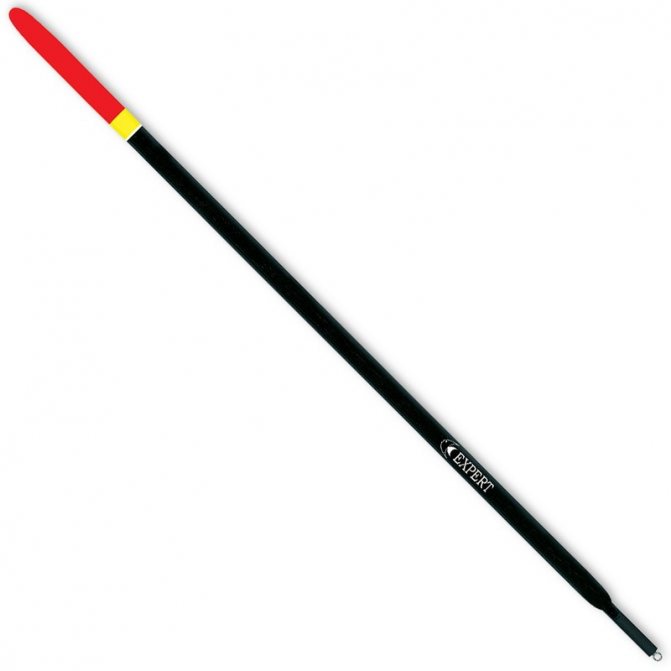
4.7 Flat float
Disc-shaped, fastened in the form of a keel mounted on the body at an angle of 45 degrees. Stable in any current.
Flat floats are used:
- when fishing with plug tackle in a body of water with a current. The essence of using this type of float is that the fisherman holds the equipment at one fishing point and at the same level with the tip of the tackle;
- when fishing with a rod and reel, close to the shore.
The peculiarity of the float is the accurate registration of bites during the current, due to its shape, due to which the float is less susceptible to pressure from the water, which is compensated by the fishing line and the keel maintains its vertical position above the water surface and is visible to the fisherman.
4.8 Antennaless float
A float without an antenna is a dibber. Refers to floats that work on the surface of the bite, ideal for fishing in shallow water areas and for long casts. Used in carp fishing, crucian carp and bream fishing.
When properly loaded, the float is not visible to the fisherman, since its body is hidden in the water column, and the equipment is at the bottom.
How an antennaless float works - as soon as the fish swallows the bait, the float rises to the surface, which is a bite signal.
Choosing a match rod. What you need to know to avoid biting your elbows.
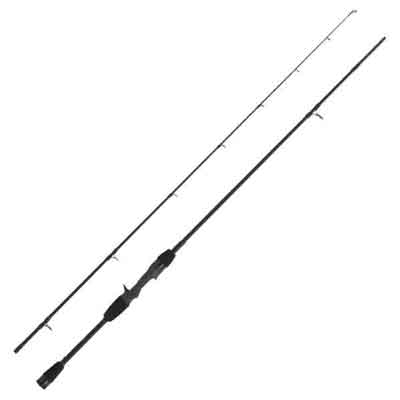
For the first time, the British began fishing with mast rods; a feature of mast fishing is the use of a “wagler” type float (a float that has one attachment point, to which the center of gravity is shifted), it allows long casting and fishing at a distance of 50-60 m, at a depth of 70 cm to 15 m. Now let’s talk in more detail about choosing a match rod.
Choosing a match rod depending on length
In order to figure out what length of match we need, we need to decide what equipment we will use to catch, for example, if it is a small white fish, such as ram, bleak, then it is better to use blind equipment to catch them. Blind-mounted rods are selected from 4.2 m to 4.5 m in length; in cases where the reservoir is quite deep, some anglers use sticks 4.8-5.5 m long, but it will be much harder to fish with them, especially if you are fishing against wind.
If you use a sliding rig, you still shouldn’t take an excessively short rod, since we need to pick up the slack when biting. In this case, the choice of a match rod should vary between rods with a length of 3.9 to 4.2 m. Therefore, rods with a length of 4.2 m will be quite universal, suitable for fishing in any conditions: ponds, bays, reservoirs.
If you are going to fish in commercial reservoirs with shallow depths, then a 3.9 m long rod will be enough for any equipment.
Plug or telescopic match rod
If you are going to purposefully fish on a mast, then definitely choose a plug rod
Pros of the plug:
- It has fewer joints, which is why the blank has a better structure (and this is relevant both for anglers wondering which spinning rod is better to choose, and for those who are thinking about choosing a feeder)
- More durable than a telescope, it is also worth noting that in general, plug rods are of higher quality than telescopic rods.
Minuses:
- Transport length. Typically, a plug rod consists of three legs (there are also two-part ones) and not every machine can accommodate them, and a telescope can sometimes even be transported in a backpack.
- The plug has to be equipped directly on the pond, thread the fishing line through the rings, and mount the float. Although this is a minus only for the impatient, because direct assembly on a pond allows us to equip a fishing rod for a specific body of water and fishing conditions. But we equip the telescope while still at home.
Choosing a match rod based on action and stiffness
If you are going to catch large carp, then you are better off using rigid, slow-action rods; they will allow you to confidently absorb the jerks of the fish, and at the same time will not bend like a donut.
In cases where we are going to catch small white fish, rudd, roach, then soft rods of medium or slow action are suitable. This will give us the opportunity to use fishing line of the smallest diameters, since these rods, due to their softness, will absorb the blows and jerks of the fish, but a hard match will only break the equipment during hooking or jerking of the fish.
Rigid rods with fast action ensure fishing at the longest distances from the shore, using heavy floats. They perfectly push the wind when casting and provide high-quality hooking. It is worth remembering that long casting is often designed to catch large fish, and rigid rods with fast action are not designed to dampen its jerks and forgive mistakes, so the angler will have to use all his skill and adjust the friction as efficiently as possible.
Fast, but soft, match rods are a kind of universal tackle. They are excellent for fishing with blind equipment; their softness also allows them to dampen fish jerks, and their action ensures high-quality hooking and the ability to control prey when fishing. So this is an excellent tackle for catching small bream, carp, as well as heavy roach and ram.
One important point to consider when choosing inexpensive match rods. There are often situations when a shorter stick has a very good action, and a slightly longer one has a snotty and sausage-like action. For example, a rod of one model, with a length of 3.9 m, has an excellent action, but if you take a blank of the same model, but only 4.2 m long, then it is no longer clear what kind of misunderstanding this is.
Match rod material
Mostly, carbon fiber rods are used, since fiberglass blanks are harder to find than inexpensive but fairly good carbon blanks. The price of carbon fiber rods depends on the value of the elastic modulus, the larger it is, the higher the price. It is also worth remembering that the higher the elastic modulus, the more carefully you need to handle the rod, avoid sudden overloads and mechanical shocks, for which purpose transport forms in tubes and cases .
Choosing a match rod depending on the test
The lightest rods are rods that are designed for a test of 2-15 g; floats with an equipment weight of 5-10 g are suitable for this test. These fishing rods are well suited for fishing not far from the shore in light winds.
Rods with dough 5-25 gr. quite versatile and often have a length of 4.2 m.
The choice of a match rod with a test weight of 30-40 g occurs in cases where it is necessary to fish at the longest distances in windy weather. With such rods it is easy to cast over a distance of 50 m (you can go further, but when fishing at longer distances, it is difficult to notice the bite).
What else you need to know to select a match
Reel seat
A match rod, unlike other float blanks, has a more reliable reel seat, which rigidly fixes the legs of the reel, for example, in a Bolognese rod, the reel seat is lightweight and does not fix it so reliably, which is immediately felt when casting and retrieving.
A reel for match fishing is selected in pairs with a form; it must be secured and checked for play, because different reel models have different legs. Often such problems arise when using budget reels and rods, but even when purchasing an expensive blank, it is better to play it safe.
Rings
They are smaller in size and there are more of them than Bolonessa, which allows you to more evenly distribute the load throughout the rod. The rings have longer legs so that the line is further away from the blank and does not stick when casting. Be sure to pay attention to the topmost ring, it should not be too small if you are going to use a sliding rig, otherwise the stopper assembly will get stuck or snag when casting. Also, when choosing a match rod, you should pay attention to the distance from the first ring to the reel seat. If the ring is too close, then the rod is designed to accept an inertia reel, and when you install a non-inertia reel on such a rod, you will most likely have problems with long casting.
Since match fishing does not use braided line, rings with aluminum oxide or zirconium ceramic inserts are perfect.
Lever
It is mainly presented in three versions - cork, neopreon and a combination of both. A cork pen gets dirty less and is easier to clean from dirt than a neoprion pen, in which dirt gets stuck in the pores. As for the length, here everyone chooses for themselves, the only thing is, don’t be lazy and spread out the form over its entire length, install a reel on it, then make a couple of casts and hooks, standing and sitting, in order to determine how comfortable the mast fits in your hand.
Manufacturers
When choosing manufacturers, you should pay attention to the English companies Drennan, Preston, Middy, Fox, the Italians Maver, Trabucco, Colmic and the Japanese Shimano, but if you like the stick of the Russian Sabaneev or the Polish Mikado, then this is also a worthwhile option.
Video about choosing a match rod
Finally, I would like to say that in the first couple of years, until you decide where and what kind of fish you are going to catch, choosing a match rod is quite simple: it is a fast but soft blank 4.2 m long, with a cast of 5-20.

